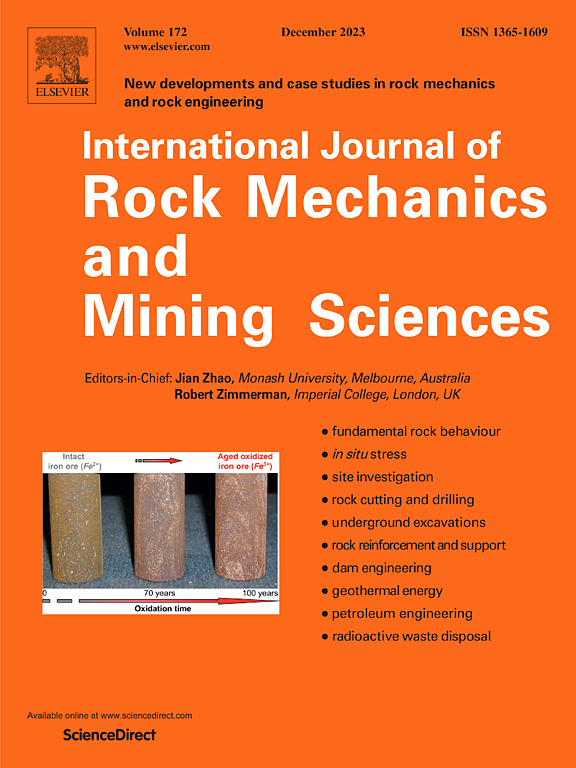Fire-induced mechanical transformations in Hawkesbury sandstone: Experimental observations and analysis
IF 7
1区 工程技术
Q1 ENGINEERING, GEOLOGICAL
International Journal of Rock Mechanics and Mining Sciences
Pub Date : 2025-04-10
DOI:10.1016/j.ijrmms.2025.106110
引用次数: 0
Abstract
A series of laboratory experiments were conducted on Hawkesbury sandstone specimens that were exposed to a simulated fire following the modified hydrocarbon fire curve (MHC). For comparison, a similar test program was performed on specimens heated at four rates (2 °C/min, 5 °C/min, 10 °C/min, and 20 °C/min) up to 1100 °C and untreated specimens. Both uniaxial compressive strength (UCS) and elastic modulus showed a significant decrease due to heating, with a more striking loss of integrity for those heated following the MHC curve; the average decreases of UCS and elastic modulus across all four linear heating rates were 31.5 % and 57.1 %, whereas those for MHC were 79.2 % and 90.0 %, respectively. A similar observation was made for the tensile strength, where the linear heating rates showed an average decrease of 58.1 %, while that for MHC was 84.7 %. Among the linear heating rates, 20 °C/min displayed the most significant weakening due to heating. The microstructural observations exhibited pervasive heat-induced inter- and intra-granular cracking within heated specimens, which were more pronounced for 20 °C/min and MHC cases due to the thermal shock, leading to increased porosity and greater deformation when loaded as observed through digital image correlation analyses. The different heating conditions proved to produce different mineralogical changes within the specimens. The quartz content increased for all heated specimens, with the greatest increase for MHC, and the increasing heating rate caused a consistent increase in mullite content. Overall, the results of this study suggest that the rocks exposed to realistic fire scenarios can undergo significant degradation of mechanical properties, which cannot be reliably replicated by testing specimens that were heated at slower, linear heating rates, and stress the importance of assessing rock performances under real fire conditions to inform the designs of fire-resilient rock structures.
霍克斯伯里砂岩的火致力学转变:实验观察与分析
在Hawkesbury砂岩样品上进行了一系列的实验室实验,这些样品暴露在模拟火灾中,遵循修改的碳氢化合物火灾曲线(MHC)。为了进行比较,在4种加热速率(2°C/min, 5°C/min, 10°C/min和20°C/min)至1100°C的样品和未处理的样品上执行类似的测试程序。单轴抗压强度(UCS)和弹性模量均因加热而显著降低,沿MHC曲线加热的完整性损失更为显著;在所有四种线性加热速率下,UCS和弹性模量的平均下降幅度分别为31.5%和57.1%,而MHC的平均下降幅度分别为79.2%和90%。拉伸强度也有类似的观察结果,线性升温率平均下降58.1%,而MHC的平均下降率为84.7%。在线性升温速率中,20°C/min的升温幅度最大。显微组织观察显示,加热试样中普遍存在热致颗粒间和颗粒内裂纹,在20°C/min和MHC情况下,由于热冲击,这种裂纹更为明显,导致孔隙率增加,加载时变形更大,通过数字图像相关分析观察到。不同的加热条件在试样内部产生不同的矿物学变化。所有加热试样的石英含量均增加,其中MHC含量增加最大,升温速率的增加导致莫来石含量的持续增加。总的来说,这项研究的结果表明,岩石暴露在真实的火灾场景中,其机械性能会发生显著的退化,而在较慢的线性加热速率下加热的测试样品无法可靠地复制这一点,并强调了在真实火灾条件下评估岩石性能的重要性,从而为火灾弹性岩石结构的设计提供信息。
本文章由计算机程序翻译,如有差异,请以英文原文为准。
求助全文
约1分钟内获得全文
求助全文
来源期刊
CiteScore
14.00
自引率
5.60%
发文量
196
审稿时长
18 weeks
期刊介绍:
The International Journal of Rock Mechanics and Mining Sciences focuses on original research, new developments, site measurements, and case studies within the fields of rock mechanics and rock engineering. Serving as an international platform, it showcases high-quality papers addressing rock mechanics and the application of its principles and techniques in mining and civil engineering projects situated on or within rock masses. These projects encompass a wide range, including slopes, open-pit mines, quarries, shafts, tunnels, caverns, underground mines, metro systems, dams, hydro-electric stations, geothermal energy, petroleum engineering, and radioactive waste disposal. The journal welcomes submissions on various topics, with particular interest in theoretical advancements, analytical and numerical methods, rock testing, site investigation, and case studies.

 求助内容:
求助内容: 应助结果提醒方式:
应助结果提醒方式:


